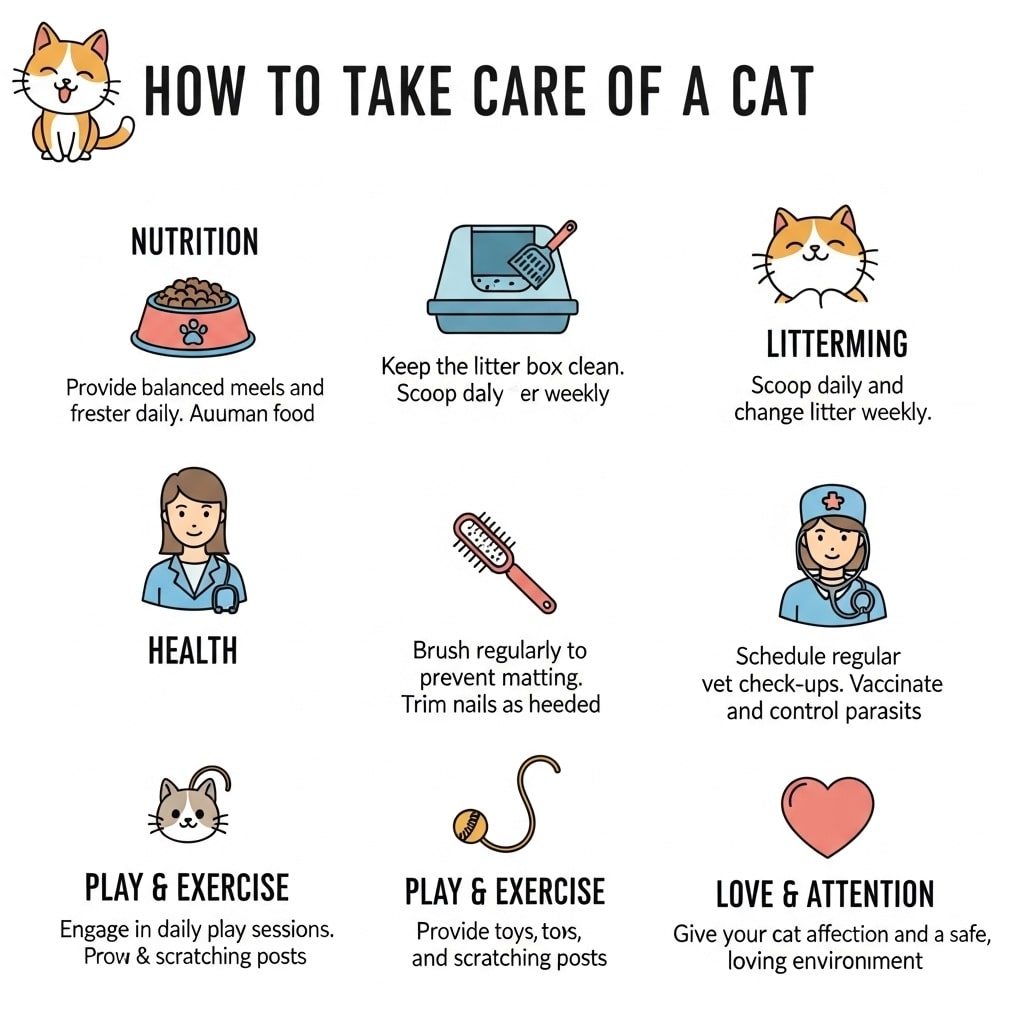🐾 Introduction
A cat can be a wonderful companion, but being a responsible cat owner means providing for all its needs, from a healthy diet to a safe and stimulating environment. This guide will walk you through the essentials of cat care.
Cats are more than just pets—they are companions, stress-relievers, and often, a member of the family. They are admired for their independence, agility, and playful nature, but they require dedicated care to thrive. Proper cat care goes beyond feeding and litter boxes; it encompasses nutrition, grooming, health care, training, mental stimulation, and understanding feline behavior.
Whether you’re a first-time cat owner or experienced with felines, this guide provides practical, detailed tips to ensure your cat enjoys a healthy and happy life.
Discover more: “VIP Pet Care: Luxury Tips for Healthy, Happy Pets”

Discover More: Puppy Potty Training Tips: Complete Guide for New Owners
🏡 1. Preparing Your Home for a Cat
Bringing a cat home is exciting, but preparation is key. A safe and comfortable environment helps your cat settle quickly and reduces stress.
🧹 1.1 Cat-Proof Your Home
Cats are curious creatures and often explore nooks and crannies that may be dangerous.
- Toxic plants: Remove plants like lilies, poinsettias, aloe vera, and azaleas, which are harmful if ingested.
- Chemicals and medications: Keep household cleaners, insecticides, and prescription medications out of reach.
- Electrical cords: Cats may chew cords; secure them with cord protectors or tape.
- Small objects: Items like hair ties, rubber bands, or small toys can be choking hazards.
🛏️ 1.2 Create a Comfortable Space
Cats love cozy, private spaces.
- Sleeping area: Provide a soft bed in a quiet, draft-free corner. Some cats prefer high perches, while others like enclosed spaces.
- Scratching post: Essential for claw maintenance and to prevent furniture damage. Vary textures—sisal rope, cardboard, and wood.
- Litter box: Place in a low-traffic, quiet area. Avoid placing it near food and water bowls.
🛒 1.3 Initial Supplies Checklist
- Cat bed and blanket
- Scratching posts or pads
- Litter box and litter
- Food and water bowls
- Cat carrier for travel
- Toys for mental stimulation
- Grooming tools (brush, nail trimmer)
🍽️ 2. Choosing the Right Food
Proper nutrition is crucial for your cat’s overall health. Cats are obligate carnivores, meaning they need a diet rich in animal protein.
🥫 2.1 Types of Cat Food
Dry Food (Kibble):
- Convenient and long shelf life.
- Helps reduce plaque and tartar buildup.
- Ensure it is high in protein and low in fillers like corn or wheat.
Wet Food (Canned):
- Contains 70–80% moisture, aiding hydration.
- Highly palatable and ideal for picky eaters.
- Provides variety and prevents urinary tract issues.
Raw or Homemade Diets:
- Must be balanced to avoid deficiencies.
- Consult a vet to ensure correct nutrition.
🕒 2.2 Feeding Schedule
- Kittens (0–6 months): 3–4 meals per day for energy and growth.
- Adult cats (1–7 years): 2 meals per day, with controlled portions to prevent obesity.
- Senior cats (7+ years): Adjust portions and protein levels according to health needs.
🚫 2.3 Foods to Avoid
- Toxic foods: Chocolate, caffeine, onions, garlic, grapes, raisins.
- Bones: Small bones can splinter and cause internal injuries.
- Dairy products: Many cats are lactose intolerant, leading to diarrhea.
🧼 3. Grooming Your Cat
Cats are naturally clean, but regular grooming supports skin health, prevents hairballs, and strengthens your bond.
🧹 3.1 Brushing
- Long-haired cats: Daily brushing prevents mats and tangles.
- Short-haired cats: Brush 2–3 times per week to remove loose fur.
- Benefits: Reduces hairballs, stimulates circulation, and allows you to check for skin issues.
🛁 3.2 Bathing
- Rarely needed unless your cat gets dirty or has a medical condition.
- Use cat-safe shampoos and lukewarm water.
- Dry gently with a towel or low-heat hair dryer.
✂️ 3.3 Nail Trimming
- Trim every 2–3 weeks.
- Avoid cutting the quick (the pink part inside the nail) to prevent pain and bleeding.
- Scratching posts help naturally wear down nails.
🦷 3.4 Dental Care
- Brush teeth 2–3 times weekly with cat-specific toothpaste.
- Offer dental treats or toys to reduce plaque.
- Regular dental checkups prevent periodontal disease.
🏥 4. Health Care Essentials
Maintaining health is more than vaccinations—it’s about monitoring and preventive care.
💉 4.1 Vaccinations
Core vaccines:
- FVRCP: Feline viral rhinotracheitis, calicivirus, and panleukopenia.
- Rabies: Legally required in many areas.
- FeLV (Feline Leukemia): Recommended for outdoor cats or multi-cat households.
🐛 4.2 Parasite Control
- Fleas and ticks: Use monthly topical treatments or oral medications.
- Deworming: 2–4 times per year depending on age and lifestyle.
🩺 4.3 Regular Vet Checkups
- Kittens: Every 3–4 weeks until 16 weeks old.
- Adults: Annual exams.
- Seniors: Every 6 months for chronic disease monitoring.
🚨 4.4 Signs of Illness
- Change in appetite or water intake
- Lethargy or hiding
- Vomiting or diarrhea
- Excessive scratching or hair loss
🚽 5. Litter Box Training
A clean litter box is vital for your cat’s comfort and hygiene.
🧼 5.1 Choosing a Litter Box
- One box per cat plus one extra.
- Open vs. covered: Some cats prefer open boxes; others like privacy.
🧻 5.2 Selecting Cat Litter
- Clumping clay: Easy to scoop.
- Silica crystals: Good odor control.
- Natural options: Pine, paper, or corn-based for eco-friendliness.
🧽 5.3 Cleaning Routine
- Scoop waste daily.
- Wash the box weekly with mild soap.
- Avoid harsh chemicals that leave strong odors.
🧠 6. Enrichment and Play
Cats need stimulation to prevent boredom and stress, especially indoor cats.
🧸 6.1 Toys
- Wand toys, balls, laser pointers, and interactive puzzles.
- Rotate toys to keep your cat engaged.
🧗 6.2 Scratching Posts and Trees
- Vertical and horizontal posts for stretching and claw maintenance.
- Place near favorite resting areas to encourage use.
🌿 6.3 Outdoor Access
- Supervised walks with a harness or catio.
- Avoid free roaming to reduce injury and exposure to diseases.
🐾 7. Understanding Cat Behavior
Cats communicate primarily through body language and vocalizations. Understanding this helps prevent stress and behavior problems.
🐾 7.1 Body Language
- Tail up: Happy and confident
- Arched back: Scared or defensive
- Slow blink: Affection and trust
🐱 7.2 Common Behavior Issues
- Scratching furniture: Provide posts and reward use.
- Litter box accidents: Rule out medical issues or stress.
- Aggression: Identify triggers, use positive reinforcement, and consult a vet if persistent.
🐈 8. Caring for Senior Cats
Older cats have unique needs, including dietary adjustments and more frequent health monitoring.
🍽️ 8.1 Diet and Nutrition
- Senior-specific diets: Lower calories, higher fiber, joint supplements.
🩺 8.2 Health Monitoring
- Watch for kidney disease, diabetes, dental issues, and arthritis.
- Regular vet checkups every 6 months.
🛋️ 8.3 Comfort and Environment
- Easy access to litter boxes, beds, and food bowls.
- Provide gentle play and mental stimulation to prevent cognitive decline.
✈️ 9. Traveling and Relocation
Cats are creatures of habit, so travel can be stressful.
🧳 9.1 Carrier Training
- Introduce the carrier slowly with treats and toys.
- Keep it in a familiar space before travel.
🚗 9.2 Travel Tips
- Provide water and occasional food.
- Use calming pheromone sprays or blankets.
- Never leave cats in hot cars.
🐱 10. Adopting a Cat
Adoption is a rewarding experience but requires preparation and understanding.
🐾 10.1 Choosing the Right Cat
- Consider age, breed, temperament, and lifestyle compatibility.
🏠 10.2 Preparing for Adoption
- Stock up on essentials.
- Schedule a vet checkup within a week.
🐾 10.3 Integration
- Allow time to adjust.
- Gradual introductions if you have other pets.
❓ 11. Frequently Asked Questions
Q1. How often should I feed my cat?
- Kittens: 3–4 times daily; Adults: 2 times; Seniors: Adjust based on health.
Q2. How long do cats live?
- Indoor cats: 12–18 years; some up to 20+ years.
Q3. Can cats eat human food?
- Only small, safe portions. Avoid toxic foods like chocolate, grapes, onions.
Q4. How do I stop my cat from scratching furniture?
- Provide scratching posts and reward proper use.
Q5. How do I know if my cat is sick?
- Monitor behavior, appetite, litter box habits, and energy levels.
